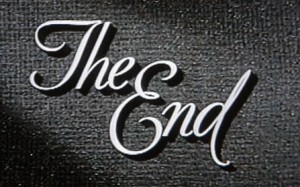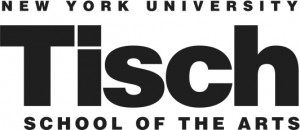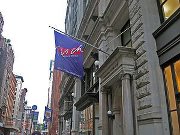I wound up the preceding post in this series by pinpointing the process through which BFA/MFA thesis project proposals, and the ensuing thesis projects themselves, get generated as the source of the sameness afflicting so many images and so many projects today. Let me expand on that diagnosis.
Insofar as thesis proposals go, as the one doing the proposing, in the student’s unenviable yet inevitable position as supplicant before those in power, one rationally seeks a proposal to which one’s thesis advisors can’t say no, and that provides a quick and reliable path to a completed thesis project that the advisory committee must automatically approve. That’s the most efficient way to acquire the BFA/MFA degree, which, most would agree, is the primary reason for entering a program that grants same.
Fortuitously for those involved on both sides, there’s a symbiosis here. Because what overworked and underpaid faculty thesis advisors want in that thankless role are proposals that self-justify and need little or no defense, and that, furthermore, provide their proposers with such clear and simple guidelines toward a satisfactorily resolved end result that they’ll require minimal actual advisement along the way. The outcome, entirely predictable from the project’s inception, can thus get ceremonially but rapidly rubber-stamped by the thesis committee without any contention, leaving them free to move on to more important matters.
Projects that involve the pursuit of anything idiosyncratic to the student — quirky ideas that may (but may not) lead to something, investigations of aspects of photographic seeing as a mindset — tend to get discarded in favor of concepts (I use the term advisedly) on which advisor and advisee can count. You don’t want to have to start again from scratch at the beginning of the spring semester of your final year, now do you? Are you ready to take a chance on having the academic equivalent of the Flying Spaghetti Monster refuse to touch you with His Noodly Appendage?
No, what works best is something socially themed, manageable in size, its end product previsualized, with the chance factors severely restricted. Such concepts slide through the approval-to-review process like shit through a goose because, regardless of ethnicity, those who teach in and administer post-secondary photo-ed programs are for the most part white liberals attitudinally. This leaves them exceedingly vulnerable to the charge levelled against me here by one commenter, that concern about such trivia as formal values signals that I don’t “care about the subjects” of these projects. An array of projects manifesting the attitude once dubbed “concerned photography” (to borrow a fatuous term from the late Cornell Capa), ostensibly initiated spontaneously by students, effectively insulates a department and its individual faculty members from charges of insufficient commitment to the social issues du jour.
(Heaven forfend that I should stand accused of “not caring” about any of the infinity of microcultures susceptible to photographic documentation, apparently. Frankly, my dear, I don’t give a damn; I’m reasonably confident in the health of my social conscience and the muscle tone of my sense of active citizenship. But I don’t make my living in academe, where any accusation of insensitivity to issues of “diversity,” “marginality,” etc., no matter how specious or frivolous, can land you in a world of hurt.)
Lake Wobegon Days
Post-secondary photo education ain’t rocket science. In fact, it ain’t science at all. Once upon a time it involved learning some science (basic optics, densitometry, sensitometry, photo chemistry, all that toe-and-shoulder, D log E curve stuff). But that got largely discarded from the curriculum of fine-art photo departments in the 1970s as troublesome interference in the otherwise pleasurable work of making images, and became obviated entirely by the advent of digital imaging.
Also, because such thesis projects are system-based from the outset, with a clear methodology spelled out in the proposal, they do not run the risks inherent in free-range projects that evolve organically: strange alluring bypaths and offshoots, unexpected dead ends, even eventual but instructive failure. Unless you’re unable to to find 40 veterans with post-traumatic stress disorder willing to sit for their portraits and talk about their experiences, how can such a project go wrong?
Projects of this type prove especially reassuring to the outside advisors and thesis-committee members from other disciplines that many degree-granting programs require, precisely because they eschew the unquantifiable (the development of a personal way of seeing) in favor of the reassuringly taxonomic. Why, they’re almost . . . scientific, the status to which all academic disciplines aspire. (In truth, they’re about as scientific as soi-disant “scientific socialism,” but that’s another discussion.)
 Indeed, post-secondary photo education is notoriously one big gut course, evidenced by the facts that nobody flunks photography and a GPA below A-minus has become unusual in most such programs. Social promotion, grade inflation, the overall lowering of the basketball hoops, are the norm. (Like the children of Lake Wobegon, all post-secondary photo students are above average.) Over the past decade I’ve guest-taught at two schools — one a BFA program in a university, the other an MFA program in an art school — that tacitly required me to grade all my students between A-plus and A-minus, lest they lose tuition remission and other financial perks, an imperative not disclosed to me until I turned in my initial grade sheets.
Indeed, post-secondary photo education is notoriously one big gut course, evidenced by the facts that nobody flunks photography and a GPA below A-minus has become unusual in most such programs. Social promotion, grade inflation, the overall lowering of the basketball hoops, are the norm. (Like the children of Lake Wobegon, all post-secondary photo students are above average.) Over the past decade I’ve guest-taught at two schools — one a BFA program in a university, the other an MFA program in an art school — that tacitly required me to grade all my students between A-plus and A-minus, lest they lose tuition remission and other financial perks, an imperative not disclosed to me until I turned in my initial grade sheets.
Given that condition, which does not pass unnoticed by faculty in other disciplines, anything suggesting that the study of photography in a studio arts program has its rigors is welcome. Aside from the thesis project, BFA/MFA photo education has nothing along those lines to offer. Hence the evolution of the thesis project from what functioned as a senior-year challenge in the 1960 and ’70s into the version on steroids that dominates post-secondary photo education today.
Sidebar
Perhaps a sketch of my own experience with the evolution of the BFA thesis project at a particular institution will cast some light on how and why this (and its MFA counterpart) has turned into such a formative, watershed moment in the creative life of the academically trained photographer.
When I began teaching courses in the history and criticism of photography at New York University’s Tisch School of the Arts in 1977, I did so within what was then a component of the undergraduate film & television program — a small cluster of service courses in still photography initially required of NYU’s film & tv students. As it happened, I found myself at that moment “between roles,” as actors like to say: I had no regular platform for my writing aside from a camera magazine, and was in the process of becoming the full-time custodial single parent of my nine-year-old son Edward, which would radically delimit my ability to travel in order to give short workshops and public lectures. So steady work as adjunct faculty had a definite appeal.
The Tisch program when I joined it was in its start-up phase. At the invitation of the then-chair of the undergraduate film & TV department, a group of recent BFA grads from Minneapolis had moved to New York, sharing the salary and benefits of one full-time faculty line in order to consolidate and refine the department’s foundation courses in still photography. (This was a late-blooming version of the way that many of the already established BFA and MFA photo programs had come into existence.)
At that point, Tisch film & tv undergrads could get their degrees with a concentration in photography, but not a degree in photography per se. Nonetheless, the faculty with which I became involved there thought of themselves and their courses as a department, which is how they referred to it then, how I quickly came to refer to it, and how I’ll refer to it here, for simplicity’s sake.
In order to graduate, our students had to make some final presentation, usually consisting of the individual’s work in progress — whatever they’d done over the course of their senior year. We had a senior show, for which planning began about two months before the end of the spring semester. The students hung their selections, often unfinished, on the walls of the department’s corridors. We had an intramural “opening” to which only the students, their friends and significant others, their parents, and the faculty got invited. A few days later it came down, undocumented aside from whatever installation shots the faculty and students themselves made and the snapshots generated during the opening.
 The further this department moved toward accreditation as an autonomous program, the more specific and rigorous the guidelines for that final project became. I didn’t consider that a bad thing, necessarily, though even with accreditation this would remain an undergraduate program. At Tisch and elsewhere, BFA degrees in other media, from acting to creative writing to sculpture and painting, did not then and do not now automatically mandate thesis projects for graduation, often just successful completion of a minimum number of course credits.
The further this department moved toward accreditation as an autonomous program, the more specific and rigorous the guidelines for that final project became. I didn’t consider that a bad thing, necessarily, though even with accreditation this would remain an undergraduate program. At Tisch and elsewhere, BFA degrees in other media, from acting to creative writing to sculpture and painting, did not then and do not now automatically mandate thesis projects for graduation, often just successful completion of a minimum number of course credits.
In any case, as one of the benefits of my Tisch status as adjunct faculty, I had no built-in obligations to sit on or chair departmental or inter-department faculty committees, serve as student advisor, crank out reams of paperwork, or perform any of the countless other bureaucratic/administrative tasks increasingly piled on full-time teachers, especially those who go tenure-track. (They offered me a full-time tenure-track position, which I turned down.) Mostly, I taught.
(For an index of links to all posts in this series, click here.)
[Correction: The version of this post originally published stated of the NYU photography program that “At the invitation of the then-dean of the Tisch School, a group of recent MFA grads from Minneapolis had moved to New York, sharing the salary and benefits of one full-time faculty line in order to turn those service courses into an autonomous BFA photo program.” Several of those statements were inaccurate. I’ve made the necessary revisions above. My apologies for these errors, which resulted from relying on my memory of that narrative, and my thanks to Tom Drysdale of the department for setting the record straight. — A. D. C.]
•
This post supported by a donation from the VASA Project.













I continue to be amazed at the nature of some of the comments on this series. Are they saying;
1.) This issue does not exist, or
2.) It exists but you have mis-identified the causes, or
3.) It exists but academia can/should play no role in the remedy.
Some people seem so anxious to disavow any personal responsibility that they refuse to consider the reality of the issue. Relax, no one is accusing any one person of being the cause and no one artist or portfolio typifies the problem. So self-defense (or spirited defenses of individual bodies of work) are beside the point.
You do not need to be art “insider” (whatever that may be) to recognize the issue. All you need is a dedication to looking at lots and lots of photography and an open mind.
Having recognized that the issue exists, the only valid questions for anyone involved in arts education (as mentor, instructor, writer or role model) are;
“Am I part of the problem?” (Almost certainly yes, though not necessarily from ill-will or intent), and,
“Can I be a part of the solution?” (Yes, if you can lay down your defenses long enough.)
This issue cannot reasonably be dismissed as the rumbling of the malcontents and never-were’s of photography. The complaints about the stagnant nature of photography are being heard from many, diverse quarters, online, in print and over innumerable cups of coffee. Artists and instructors have a choice here, be a part of the forward evolution of photography or become a part of it’s (honored) past faster than you may have wished.
Thank you for this — to date, the most cogent, substantive, and useful response to the issue I’m raising in this series of posts.
“The more social the discipline the more retarded its development.” Robert Trivers, from The Folly Of Fools, The Logic of Deceit and Self-Deception in Human Life.